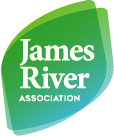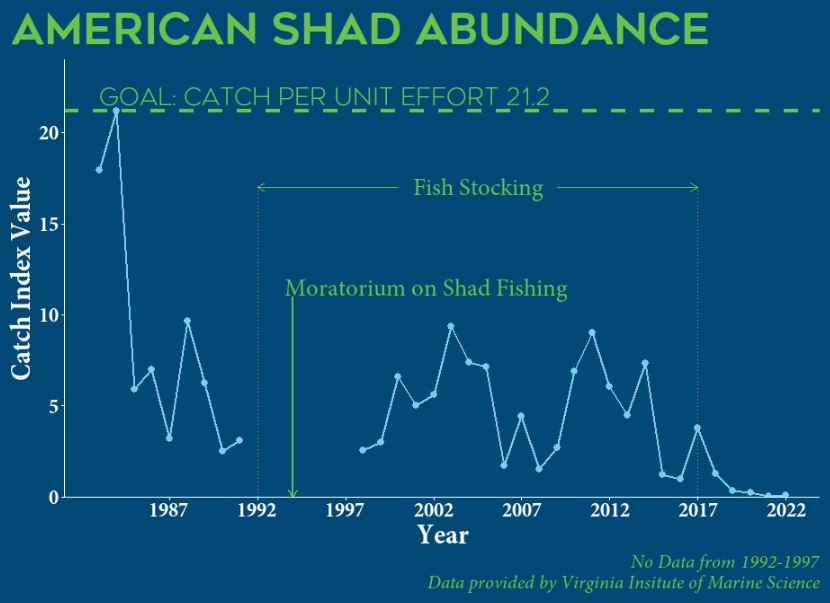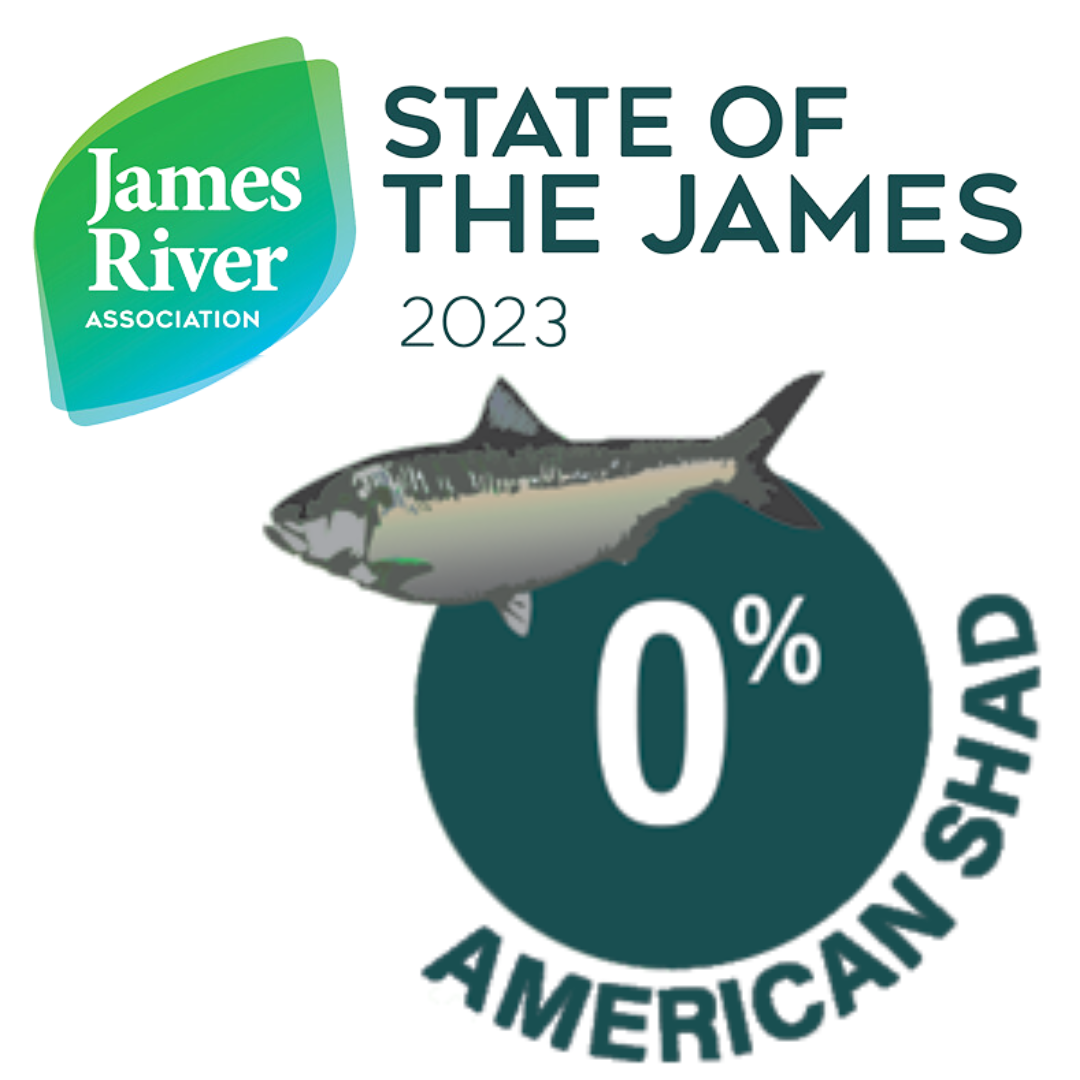Saving American shad - The Founding Fish
American shad was once one of the largest commercial fisheries along the Atlantic coast.
Shad historically held significant economic and cultural value in the Commonwealth, in addition to filling a critical ecological niche in Virginia’s rivers and the Chesapeake Bay. The 2020 American shad stock assessment found that coastwide populations of American shad were depleted, and noted that “multiple factors are likely responsible for shad decline such as overfishing, inadequate fish passage at dams, predation, pollution, water withdrawals, channelization of rivers, changing ocean conditions, and climate change.”
Shad have been particularly impacted by these factors in the James River watershed, where annually monitored shad abundance levels have reached all-time lows. Since 2021, the Virginia Institute of Marine Science’s (VIMS) monitoring data has American shad at 0% of the Chesapeake Bay Program’s shad abundance goal for the James River, underscoring the need for a recovery effort.
With the extensive cooperation of multiple Virginia stakeholders, including government agencies, academic institutions, Virginia tribes, and non-profits including JRA, a recovery plan aimed at the long-term restoration of the American shad population in the river was completed in 2023. With this framework for recovery as a guide, JRA will continue to strive for the recovery of this iconic species in the James.
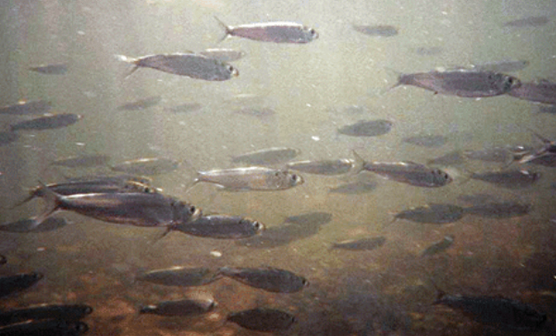
Photo: U.S. Fish and Wildlife Service
Join our River Reps
The 2023 American shad stock assessment by the Virginia Institute of Marine Science found that populations of American shad in the James are at an all time low. Given the dire situation, JRA fought for funding to develop an emergency recovery plan that identified immediate actions that could be taken to improve the American shad fishery in the James River. This plan will be delivered to Virginia Legislators in the fall of 2023 with more actions to follow.
American Shad Recovery Plan
Delivered to the Virginia General Assembly in the Fall of 2023, A Framework for the Recovery of American Shad (Alosa sapidissima) in the James River, Virginia provides a consolidated look at the plight of the American Shad in the James, and lays out the next steps for recovery of the species. Or for quick reading, review the James River Association’s fact sheet for the recovery plan: Bringing Back American Shad.
Key Takeaways from the Recovery Plan
- The recovery plan identifies several principal factors likely responsible for the decline of American shad in the James, including limitations in habitat access, impacts from invasive species, and challenges with surface water intakes.
- This recovery plan provides recommendations to enhance American shad stocks in the James River; notably, a need for further study of American shad early life history and a suitability assessment of existing habitats before significant restoration efforts can begin.
- The proposed recommendations in the plan can benefit American shad stocks and other fish species in the James River, such as other river herring species, striped bass, sturgeon, and more.
- Climate change is identified as a contributing factor, affecting had and other species during the spawning season as well as in early life-stage development and beyond. Addressing this complex issue requires a strong and unified effort from partners and agencies.
Next Steps
- Fund American Shad Projects in the James:
- Existing Spawning Habitat Assessment (1)
- Evaluate Impacts of Climate Change on American shad (1)
- Continue & Expand American Shad Sampling Efforts (2)
- And many more necessary projects called for in the recovery plan
- Ensure DEQ requires assessments of the cumulative impacts of existing and proposed water intakes on the river ecosystem and fragile species like American shad.
- Establish FDA regulation for Blue Catfish Processing, as opposed to the current costly and cumbersome USDA oversight for the fledgling industry.
-
(1) Carried out by the Virginia Institute of Marine Science
(2) Caried out by the Department of Wildlife Resources
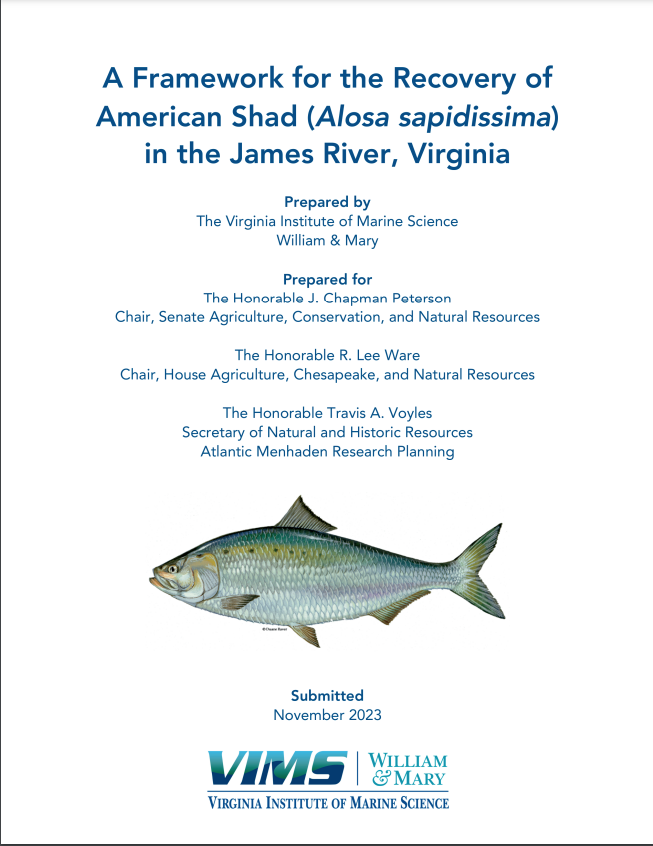
American Shad Fast Facts
- American shad is the largest species in the herring family and is native to the James River and Chesapeake Bay.
- Shad were an important food source for Native Americans, early colonists, and generations of Virginians. Shad roe is considered a delicacy by many Virginians and their Latin name Alosa sapidissima translates to “the most savory shad.”
- American shad are anadromous fish, meaning they migrate from saltwater to spawn in freshwater rivers like the James. Shad return to spawn in the same rivers where they were born and may migrate as much as 16,000 miles in their lifetime.
- Spring marks the arrival of American shad to spawn in the James River, typically when water temperatures reach 55F-65F, and when spring blooms start to appear. The shadbush (Amelanchier canadensis) gets its name American shad because it displays its white flowers close to the time shad spawn.
- Commercial landings of American shad in Virginia reached 11.5 million pounds in 1897. Harvest was less than a million pounds in 1982. In response to declines, Virginia placed a moratorium on the harvest of shad from Virginia’s rivers and the Bay in 1994.
Take Action Now
Join JRA’s Action Network or RiverReps program to help us advocate for an American shad recovery plan.
Threats to American Shad
“Death by a thousand cuts” is the expression that comes to mind to describe the current status of American shad. While overfishing and construction of dams were believed to be the early and most significant contributors to shad declines, the reality is that they face many other challenges in the James River today. For decades Virginia has dedicated resources towards dam removals, or construction of fishways that allow shad to swim around dams and reach spawning grounds. From 1992-2017, state and federal fisheries agencies in Virginia stocked 125,846,446 American shad fry in the James River. Sadly, these efforts have not yet been enough to restore shad populations. There is no single issue to blame for the loss of American shad, except to say that the challenges facing shad are human-driven. Restoring shad will require focus on a number of issues including protecting water quality and habitat, addressing water withdrawal impacts, predation from invasive species, continued focus on migratory barriers like dams, and offshore bycatch. Progress is needed on each of these issues to give American shad a fighting chance, and it will take a long-term and sustained effort to bring shad back from the brink of collapse.
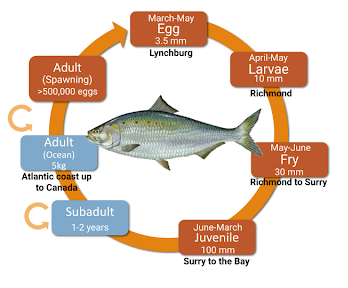
Once the threats to American shad are adequately addressed to reduce mortality throughout their lifecycle, stocking hatchery-raised shad could again be a viable option to give the species a shot in the arm. For now, continued focus on the issues is needed, and further research to inform an emergency recovery plan for this species.
Habitat and Water Quality
The James River has improved in overall water quality through the past few decades. Virginia has invested significantly in practices to reduce farm and urban polluted runoff, and to upgrade wastewater treatment facilities. These restoration actions are reducing the nutrient and sediment pollution loads to the James River, but we still have work ahead to meet Virginia’s Chesapeake Bay Cleanup goals that aim to restore the Bay and its tributaries by 2025. In particular, improvements to water clarity conditions in the James River are needed.
Underwater grass abundance, or rather the lack of underwater grasses, is one notable indication of poor water clarity in the James River. Thousands of acres of underwater grass beds once blanketed the shallows of the James River estuary, but these grasses die out when the river becomes too turbid for light to penetrate through the water. Without light, plants are unable to photosynthesize. Without underwater grass beds, we lose important habitat and ecosystems that support shad and other aquatic life. Unfortunately, underwater grass beds are at only 46% of restoration goals in the tidal James River, and are particularly sparse along the mainstem James. Underwater grass beds are critical nursery areas for young shad, providing “rest stops” as they move downstream in the summer and fall seeking refuge from predators.
Encouragingly, American shad abundance has improved over the last decade in the Potomac and Rappahannock estuaries – places that have also seen a resurgence of underwater grass beds. With a continued focus on reducing sediment pollution in the James River, we can improve water clarity conditions too, paving the way for underwater grasses and shad to return.
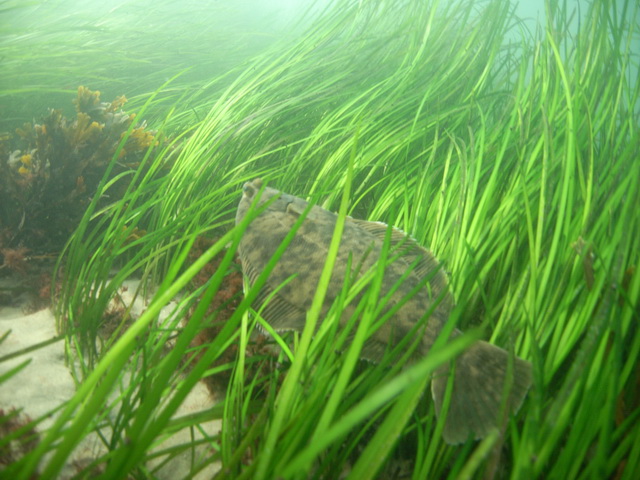
Photo: NOAA
Water Withdrawals
Water intakes can impact all life stages of fish (eggs, larvae, adults) along with any shellfish or invertebrates that lack the ability to swim away from current generated by water intakes. Aquatic life is directly impacted in two distinct ways:
- Impingement = aquatic organisms are pinned against mesh screens due to water intake velocities being too high
- Entrainment = aquatic organisms move through water intake systems due to mesh screen sizes that are too large
Virginia has developed standards for industrial water intakes that recommend minimum criteria to avoid impacts to aquatic life from impingement or entrainment. These include mesh screens appropriately sized to prevent organisms from entering a water intake, and reduced water intake velocity to prevent animals from getting pinned and killed against screens. But these standards primarily come into play when new water intakes are proposed, or when old facilities are required to renew regulatory permits. Many industries that use river water for power generation or manufacturing purposes predate these best practices and do not currently meet Virginia’s standards to minimize impacts on aquatic life.
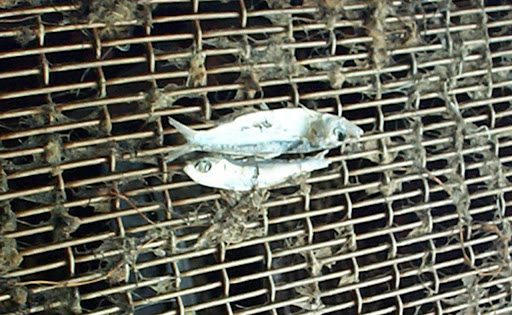
Photo: U.S. Environmental Protection Agency
More attention is needed on water withdrawals to begin reducing the risk to aquatic life, including shad. Virginia needs broader implementation of its own operation and design standards through retrofits to power plants and industries. Both Surry and Chesterfield Power Stations are going through re-permitting cycles in 2021, meaning regulators will be considering the issue of impingement and entrainment at these facilities, and the public will have opportunities to comment on these issues.
Predation
American shad are important prey for many fish species. Fortunately, shad are prolific spawners and a female can lay up to 600,000 eggs. Producing more offspring than are needed to maintain a sustainable population is a common evolutionary strategy among forage fish species like shad. In other words, shad deal with natural predation by producing a lot of young. But when non-native predator species enter the equation, things can get thrown out of balance.
Blue catfish and flathead catfish were first introduced to the James River in the 1970s as sportfish, which today has developed into a trophy fishery attracting many anglers to the region. These non-native catfish are undoubtedly preying on American shad and other native fish, but this is a factor influencing American shad abundance that is hard to quantify. Predation by non-native catfish is simply another hurdle for shad on their gauntlet run through the James River. One study by researchers at Virginia Tech explored diet preferences of these catfish and pointed out that flatheads are more carnivorous feeders (more likely to prey on species in the herring family), while blue catfish tend to be more generalists in their diet. Both will eat shad fry or adults, given the chance, and both are considered invasive species by federal and state agencies in the Bay watershed.
What’s eating our shad?
Non-native catfish of the James River:
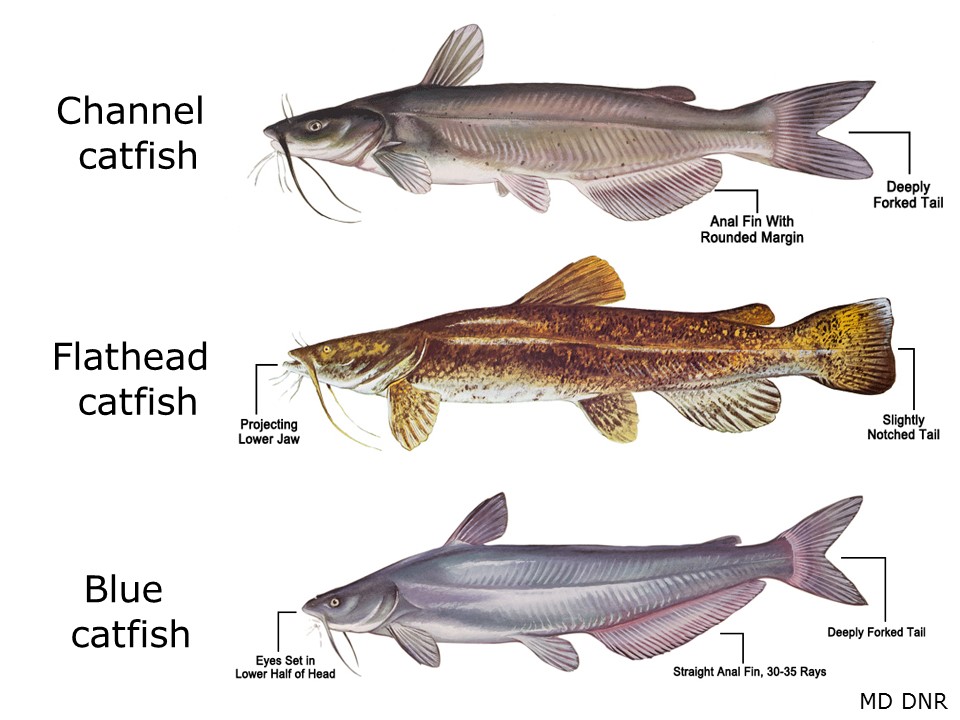
Dams
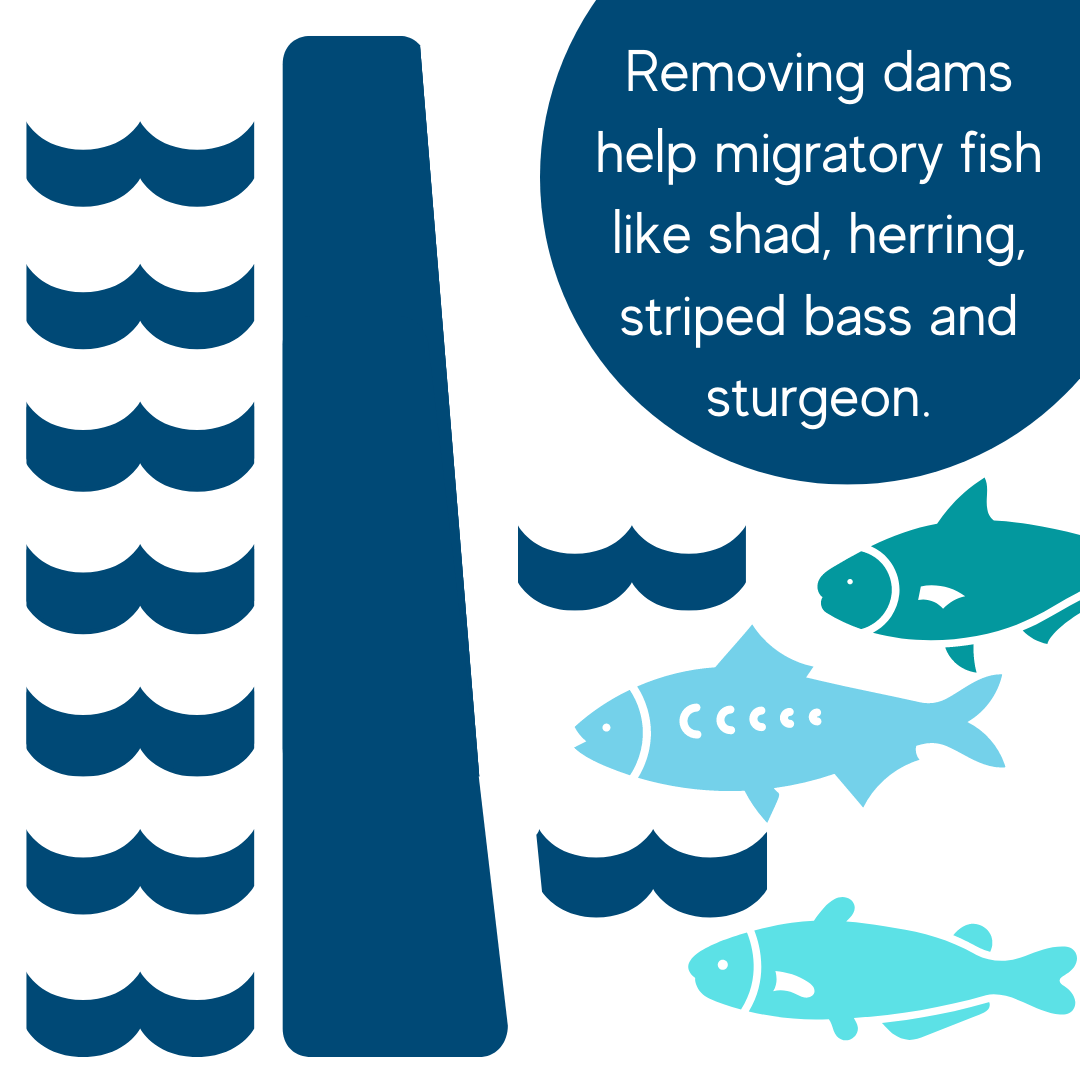
State and federal agencies in our region have long focused on dam removal as a strategy to help migratory fish like shad, herring, striped bass, and sturgeon. Notably, all of the dams on the James through Richmond and its major tributaries to the James, including the Appomattox and Chickahominy Rivers, have either had dams removed, notched, or had fish passage structures installed on them. In the 1990s, JRA played a lead role in raising resources to install the Boshers dam fishway at the western edge of the city of Richmond. This project reconnected American shad to over 140 miles of habitat west of Richmond that was previously blocked by the dam. There is evidence that American shad are reaching Boshers dam, but still many questions regarding how “passable” the fall line of the James is for shad. There is a patchwork of old dams in Richmond, which all have been breached, but may still create difficult bottlenecks for shad to ascend the rapids.
Bycatch
Virginia has a moratorium in place for shad harvest in waters of the Commonwealth, but that jurisdiction doesn’t extend into the ocean. Bycatch in the commercial fishing industry along the Atlantic coast is another suspected area where we’re losing shad. This likely contributes to fewer shad returning to spawn in rivers of the Bay watershed, and with an already much reduced population, every factor like this puts additional strain on the Founding Fish.
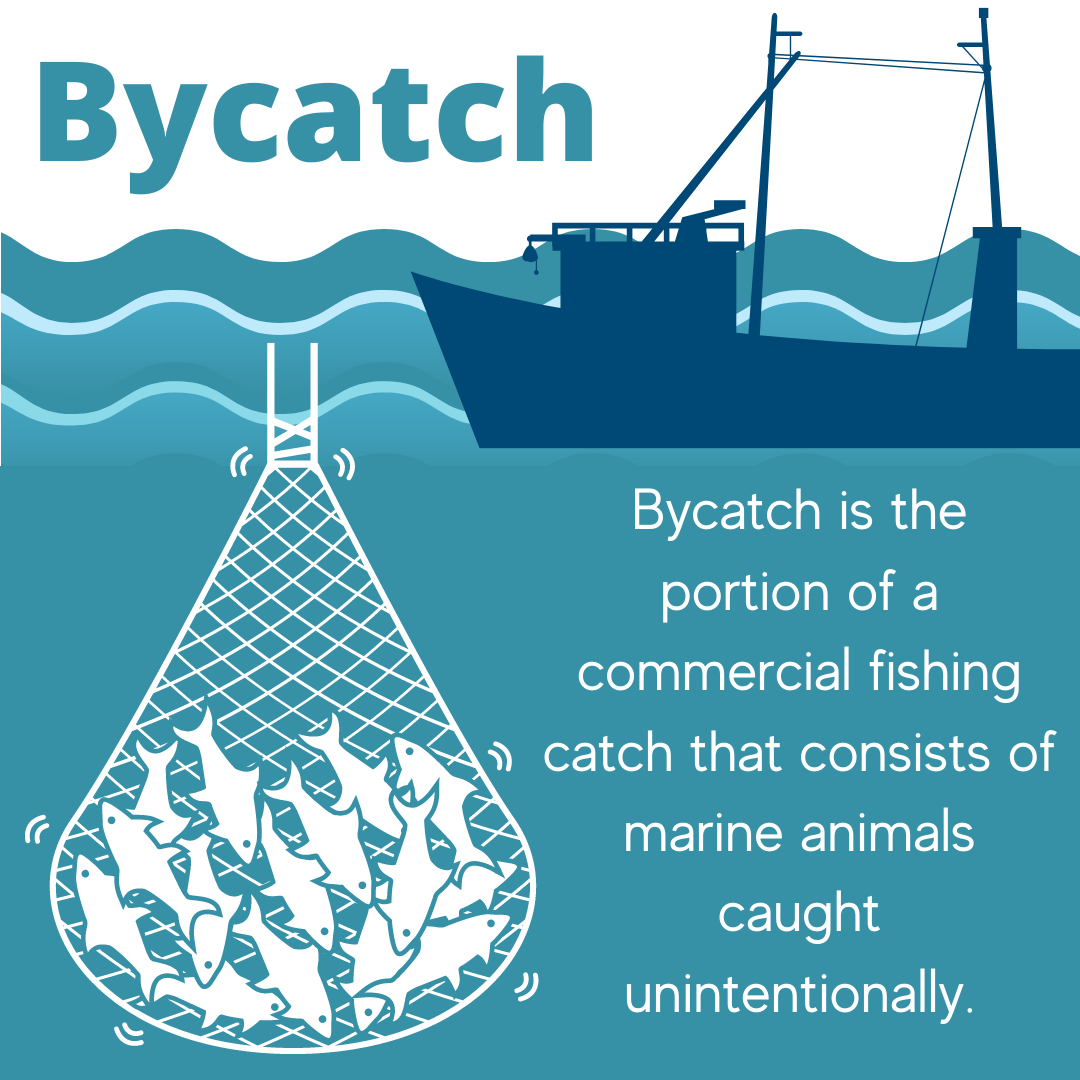
Climate change
In Virginia the climate is trending warmer and wetter. Climate change is a game changer for ecosystems and it threatens to undermine progress we’ve made to restore the James River. It also creates new hurdles for American shad that we’re just beginning to understand. Studies have indicated that warming temperatures can affect shad growth and mortality rates, shifts in spawning periods, shortened spawning seasons, or shifts in the size of American shad at maturity.
Additional Resources and References
- 2020 stock assessment for American Shad – Atlantic States Marine Fisheries Commission
- American Shad Restoration – Virginia Department of Wildlife Resources
- American Shad Monitoring – Virginia Institute of Marine Science
- Surface Water Withdrawal Intake Design and Operation Standards – Virginia Department of Wildlife Resources
- Underwater Grasses Interactive Map
- Water Withdrawal Permitting Requirements – Virginia Department of Environmental Quality
- EPA’s Cooling water intake rule
- The Blue Catfish Fishery – National Oceanic and Atmospheric Administration
- A case study of invasive blue catfish Ictalurus furcatus in Chesapeake Bay
- Aquatic barrier prioritization tool and interactive map
- Video – removal of Harvel Dam in Petersburg VA
- Gilligan-Lunda et al. 2021. Climate Change May Cause Shifts in Growth and Instantaneous Natural Mortality of American Shad Throughout Their Native Range. American Fisheries Society.

